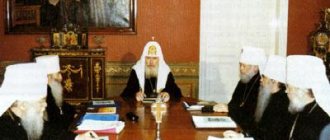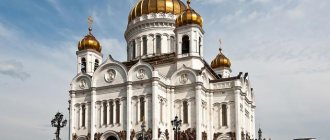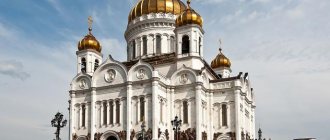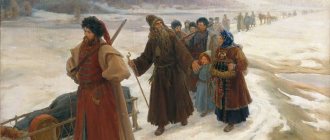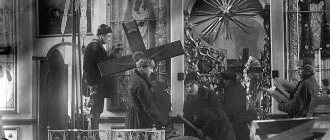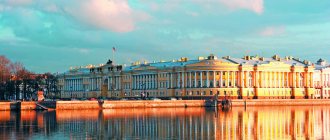| Historical building of the Holy Governing Synod in St. Petersburg |
The Holy Governing Synod
(Greek synodos - “gathering”, “meeting”, “cathedral”) is the highest body of church-administrative power of the Russian Orthodox Church, replacing the patriarch.
Not to be confused with the Holy Synod - an advisory body under the Patriarch.
Established on February 14, 1721. Abolished in 1917 in connection with the start of the All-Russian Local Council. Consisted of 79 bishops. Members of the Holy Synod were appointed by the emperor, and the Synod was governed by government officials - chief prosecutors.
The Synod is the highest church institution
The word “synod” comes from the Greek language and is translated as “assembly”, “council”. In ancient times, synods were the name given to meetings of bishops (bishops) - persons of the highest degree of priesthood. In Christian Churches the term is still used in this meaning. However, in the Russian Orthodox Church, the synod is the name of a permanently functioning highest church institution consisting of bishops. In the history of the Russian Church there were two Synods - the Most Holy and the Sacred. The latter replaced the first in 1917 and continues to exist in our time.
Cathedral of Christ the Savior - cathedral church of the Russian Orthodox Church
Holy Synod of the Russian Church
Job was elected the first Russian patriarch in 1589. Over the next century, the Church remained independent from the state. Its leader was practically equal to the king.
During the reign of Mikhail Fedorovich Romanov, the patriarchal throne was occupied by his father. Patriarch Filaret - in the world Fyodor Romanov, 1553-1633. The head of the Church was the de facto co-ruler of the sovereign and had the authority to issue his own royal decrees. For example, in accordance with one of them, the patriarch could administer justice over the peasants of the lands under his jurisdiction.
Patriarch Nikon (1605-1681) also made attempts to pursue an independent policy. For example, he protested against the Council Code of 1649. This legislative body became the first serious attempt by the state to diminish the role of the Church and subordinate it to itself. The confrontation between the patriarch and the tsar, the boyars and part of the clergy led to Nikon being defrocked and exiled to a monastery as a simple monk.
Peter I, who ascended the throne at the end of the 17th century, sought to abandon everything old. He wanted to build a new state according to the Western type. The conservative, still independent and influential Church was perceived by the reformer tsar as a serious competitor and rival. To eliminate the autonomy of the Church and integrate its system of state power, Peter I took radical measures. In 1700, after the death of the tenth Russian Patriarch Adrian, the Tsar prohibited the election of the next Primate of the Church.
In 1721, the Theological College was founded as a replacement for the patriarch. Soon it began to be called the Most Holy (the title of the head of the Church) Governing Synod. What is the Synod? It was a state institution operating on behalf of the emperor, which was engaged in church administration, divorce cases and the spiritual education of the people. The Synod consisted of representatives of the clergy appointed by the tsar, as well as one secular official (representative of the emperor) - the chief prosecutor. Over the course of the 18th and 19th centuries, the role of the latter gradually increased.
Compound
The composition and structure of the Synod were prescribed in the Spiritual Regulations. According to the document, the Council consisted of only 12 members:
- the president;
- two vice presidents;
- five assessors;
- four advisors.
In addition to the main composition, the Council included several bishops, representatives of the highest clergy and abbots of monasteries. According to the regulations, at least 3 members of the Council had to bear the rank of bishop. At the same time, the president had an equal vote with the other members.
Chief Prosecutor
In terms of the structure of its work, the Council did not differ from the Senate or the Collegium, and the Chief Prosecutor was appointed as the direct imperial representative. In 1722, he became Colonel Ivan Boltin, whose duties included not only reporting all actions to Peter I, but also monitoring the relationship of the Synod with the civil authorities, as well as the opportunity to vote against decisions made if they did not correspond to the will of the emperor.
As a result of the reform of Peter I, the Church completely lost its independence from secular power
The Chief Prosecutor was appointed and reported directly to the emperor, and over time this position ceased to be an observation one, but became a leadership one. The prosecutor controlled not only the work and decisions made by the Synod, but also all its connections with government agencies and secular authorities. Over time, the powers of the prosecutor became identical to those of the minister, and the official himself sat on the Committee of Ministers.
Senior members
Over time, the secular titles of the positions of Council members were replaced by more ecclesiastical ones, and the positions of “president” and “vice-president” began to be called “principal members”. The first leading members in the history of the Synod were:
- Stefan Jaworski;
- Feofan Prokopovich;
- Ambrose Yushkevich.
The leading member of the Synod was most often the Metropolitan of St. Petersburg.
Significance of the Synodal period
So, under Peter I, the patriarchate was abolished, and the Church became dependent on the state in all aspects, with the exception of dogmas and canons. This church-administrative body existed until 1918.
The two-hundred-year Synodal period in the history of the Russian Church was controversial. On the one hand, the reform of Peter I contributed to the significant development of church education and missionary work. Active activities were also carried out to preserve church historical monuments.
On the other hand, during the Synodal period the Church was a part of the bureaucratic system dependent on officials. She could not have an independent position on most issues. All this led to the identification of the Church with the state in the eyes of the common people and the formalization of religion. Restrictions were introduced for monasticism, and life became more difficult for the parish clergy. Hieromonk Michael (Chepel) notes:
“A rationalizing view of the processes taking place in it [the Church] and a lack of understanding of its essence led to many sad consequences, among which are attempts to resolve spiritual issues through police measures, and the departure from Orthodoxy of many representatives of the educated part of Russian society.”
Peter's church reform was largely guided by the examples of Protestant states, where the monarch is the head of the Church. In this regard, Archpriest Alexander Schmeman calls Peter’s transformations “a comprehensive transition to a Western attitude of consciousness” and “the reign of Western absolutism in Russia.”
A brief history of synodal administration from 1721 to 1918.
In the first years of his reign, Bishop Theophan had great influence on the decisions of the Synod. Not a single church book could be published without his approval.
This man was friends with Bismarck and Osterman and all the bishops, one way or another, were dependent on him. Theophanes achieved similar power after the fall of the Great Russian party in the Synod. At this time, the Soviet government was going through hard times. The confrontation between Anna Ioannovna and the daughters of Peter the Great led to persecution of those who sympathized with the latter. One day, all the members of the Synod except Feofan, following a denunciation, were simply dismissed, and others were appointed in their place, much more loyal to him. Of course, after this he achieved unprecedented power. Feofan died in 1736.
In the end, Elizabeth did ascend to the throne. After this, all the clergy exiled during Theophan’s time were returned from exile. The period of her reign was one of the best for the Russian Orthodox Synod. However, the Empress still did not restore the patriarchate. Moreover, she appointed a particularly intolerant chief prosecutor, Ya. Shakhovsky, who was known as a zealous zealot for state affairs.
During the time of Peter III, the Holy Synod of the Russian Orthodox Church was forced to tolerate German influence, which, however, ended with the accession of Catherine II to the throne. This queen did not introduce any special innovations into the Synod. The only thing she did was close the savings board. Thus, the Synod became united again.
Under Alexander I, Prince A. N. Golitsyn, who in his youth was known as the patron of various kinds of mystical sects, became chief prosecutor. As a practical person, he was even considered useful to the Synod, especially at first. Filaret, who was elevated to the rank of metropolitan by the emperor in 1826, became a prominent church figure during the time of Nicholas I. Since 1842, this clergyman took an active part in the work of the Synod.
Restoration of the patriarchate and establishment of the Holy Synod
At the beginning of the 20th century, the synodal system was increasingly criticized by representatives of the clergy and the Orthodox intelligentsia. The Church was in a state of “stagnation.” There was a growing need to convene an All-Russian Local Council to discuss the restoration of the patriarchate. The council, preparations for which had been underway since the early 1900s, was convened only in August 1917. It took place until September 1918 against the backdrop of such significant events as the fall of the monarchy, the overthrow of the Provisional Government, the October Uprising, the beginning of the Civil War, as well as the publication by the Council of People's Commissars of a decree on the separation of church and state.
The socio-political situation in the country put an end to the vacillations of the clergy and pushed them to make a decision to restore the patriarchate. Let us quote the words of Metropolitan Mitrofan (Krasnopolsky):
“The matter of restoring the patriarchate cannot be postponed: Russia is burning, everything is perishing. And is it really possible to argue for a long time now... When there is a war, a single leader is needed...”
In the fall of 1917, at the All-Russian Local Council, Metropolitan of Moscow Tikhon (Belavin) (1865-1925) was elected patriarch. The same Council established the highest governing body in the Russian Orthodox Church - the Holy Synod. This was not a modification of the old Synod, but the creation of a new, now not a state, but a church body chaired by the patriarch. The former Holy Governing Synod was finally abolished a few months later.
Members
- 1721-1722 Stefan (Yavorsky), Metropolitan of Ryazan
- 1722-1725 (acting) Theodosius (Yanovsky), Archbishop of Novgorod
- 1725-1726 (acting) Feofan (Prokopovich), Archbishop of Novgorod
- 1726-1736 Feofan (Prokopovich), Archbishop of Novgorod 1736-1740 no
The Holy Synod of the Russian Orthodox Church in the 20th century and today
In the 20th century, the Holy Synod, like the entire Church, was under pressure from the godless Soviet regime. It underwent many changes, it was disbanded and restored. Thus, in 1922, Patriarch Tikhon was arrested, and the Russian Orthodox Church remained in an “illegal situation” for 5 years without a full-fledged Synod. Later, the authorities allowed the creation of a Provisional Synod, but it was dissolved in 1935.
During the Great Patriotic War, the state made some concessions to the Church. In 1943, a permanent Holy Synod was formed. It consisted of six members chaired by Patriarch Sergius (Stargorodsky) (1867-1944). Later, the number of members of the Synod increased.
Today the Holy Synod is an advisory body under the head of the Church and consists of 12 bishops. Half of them are replaced every six months. Among the permanent members of the Synod are bishops from the Ukrainian and Belarusian Orthodox Churches (jurisdiction of the Moscow Patriarchate).
The Holy Synod oversees many church institutions: the department of external relations, the missionary department, the educational committee, the department of charity and social service, the publishing council, etc. There are also three synodal commissions: biblical and theological, liturgical, and in charge of the canonization of saints.
Background
A series of reforms by Peter the Great inspired the creation of the Holy Synod. The New Imperial Age saw radical changes and developments in the economic, social and cultural aspects of Russian life. Peter traveled to Europe twice and introduced reforms that reflected his desire to Westernize Russia, and worked to Russify European models to better suit his country. Besides forming the synod in an attempt to weaken the power and authority of the Russian Orthodox Church, it also challenged traditional Russian values, which were rooted in religion and the social structure defined by the boyars aristocracy, merchants, clergy, peasants and serfs. He did this by implementing the ideals of the Enlightenment, except those that would lead to democratization of the Russian government, tolerance of political or religious dissent, or encouragement of the free growth of thought or ideas; creation of the Julian calendar; reorganization of the Russian army in the European style; establishing a meritocracy (in contrast to the previous system of delineating positions according to aristocratic origin); prohibiting or taxing beards (which were common among Old Believers); Peter's desire to consolidate and standardize power led to the creation of a synod. With one leader (the patriarch), the church proved too great a threat to Peter's reign, and he was unwilling to share power.[1]
